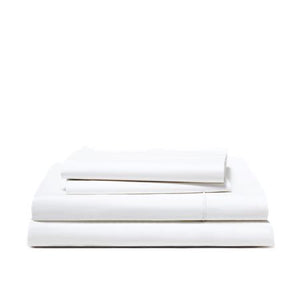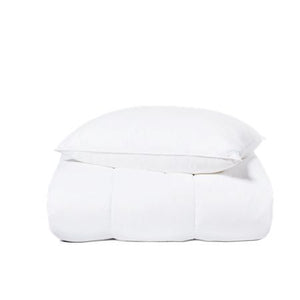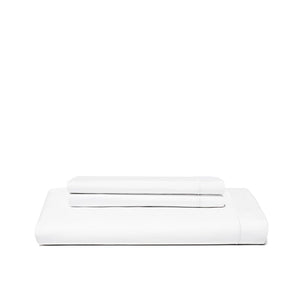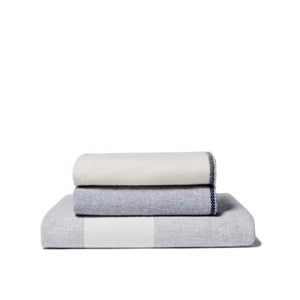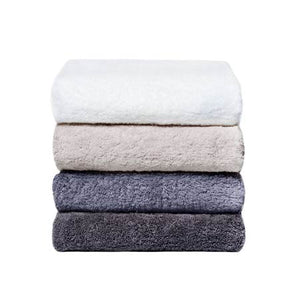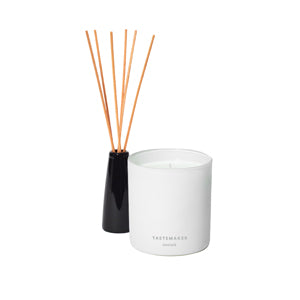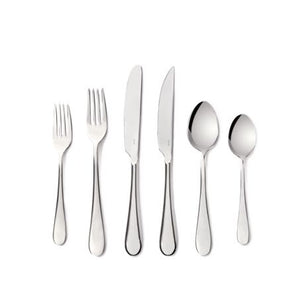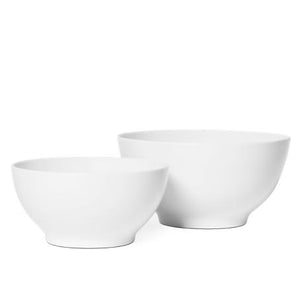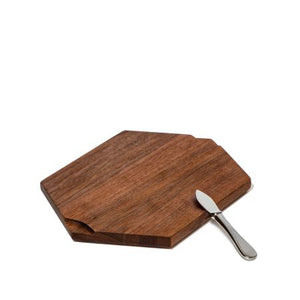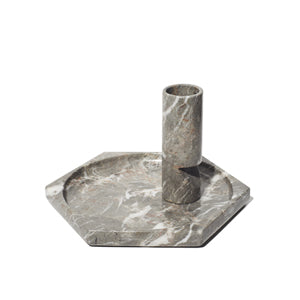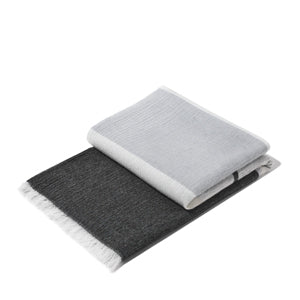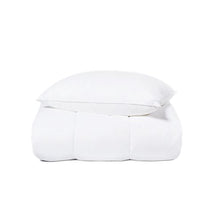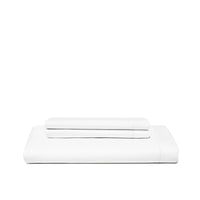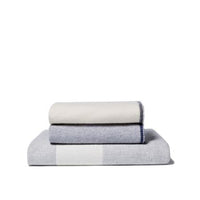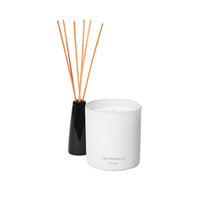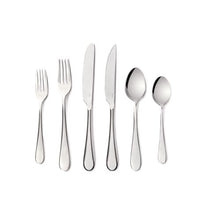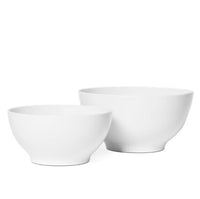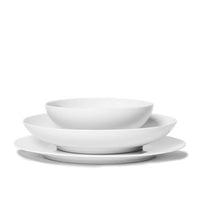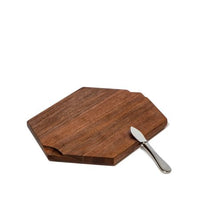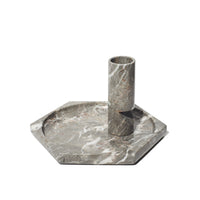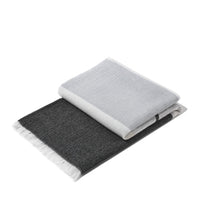If you're like most people, you probably have a comforter or two that you use during the colder months. But what do you do with them when spring and summer roll around?
Storing your comforters properly can help ensure they stay in good condition and are ready to use when the weather turns chilly again.
In this article, we'll walk you through the best ways to store comforters so you can keep them clean, dry, and protected.
Understanding Comforter Materials

When storing your comforter, it's important to understand the type of material it's made of. This will help you determine the best way to care for and store it. Here are some important things to know about comforter materials.
Natural vs Synthetic Fibers
Comforters are typically made from either natural or synthetic fibers. Natural fibers, such as down and feathers, are often preferred for their softness and warmth. However, they can be more difficult to care for and may require special cleaning methods.
Synthetic fibers, on the other hand, are often easier to care for and can be a good choice for those with allergies. They are also typically less expensive than natural fiber comforters.
When storing a natural fiber comforter, it's important to avoid compressing it too much. This can damage the down or feathers and reduce their ability to insulate. Synthetic fiber comforters can be compressed more easily, but it's still a good idea to avoid storing them in a tightly packed space.
Importance of Fabric Care Labels
Check the fabric care label no matter what type of comforter you have. This will help ensure that your comforter stays in good condition and lasts as long as possible.
The care label typically provides information on washing and drying instructions and any special care requirements.
When storing your comforter, follow any specific instructions on the care label. For example, some comforters may need to be stored in a specific position or kept away from direct sunlight.
Preparation for Storing Comforters

Before storing your comforters, it is important to prepare them properly to ensure that they remain clean and in good condition. This section will cover two important aspects of preparing your comforters for storage: cleaning and ensuring dryness.
Cleaning Before Storage
The first step in preparing your comforters for storage is to clean them thoroughly. This will help to remove any dirt, dust, or other debris that may have accumulated on the comforter over time.
To clean your comforter, follow these simple steps:
-
Check the care label on your comforter to determine the appropriate cleaning method. Most comforters can be washed in a washing machine, but some may need to be dry cleaned or hand washed.
-
If your comforter can be washed in a washing machine, use a mild detergent and set the machine to a gentle cycle. Be sure to use cold water to prevent the comforter from shrinking or losing its shape.
-
Once the washing cycle is complete, put your comforter in the dryer on low heat. Add a couple of clean tennis balls or dryer rings to help fluff up the comforter and prevent it from clumping.
-
Consider taking your comforter to a professional dry cleaner if it cannot be washed in a washing machine.
Ensuring Dryness
After cleaning your comforter, make sure it is completely dry before storing it. This will help to prevent mold and mildew from forming on the comforter while it is in storage.
To ensure that your comforter is dry, follow these simple steps:
-
After washing your comforter, put it in the dryer on low heat and let it dry completely. This may take several hours, depending on the size and weight of your comforter.
-
Once your comforter is dry, remove it from the dryer and let it cool down completely before storing it.
-
If you live in a humid climate, consider using a dehumidifier in the room where you plan to store your comforter. This will help to keep the air dry and prevent mold and mildew from forming.
Choosing the Right Storage Solutions for Your Comforter

When it comes to storing your comforter, choosing the right storage solution is crucial to keep it clean, fresh, and protected. Here are some options to consider:
Comforter Storage Bags
Comforter storage bags are an excellent choice for keeping your comforter safe from dust, dirt, and moisture. These bags are usually made of cotton or other breathable materials that allow air to circulate, preventing mold and mildew growth.
They come in various sizes, so you can choose the one that fits your comforter perfectly.
Vacuum-Sealed Options
Vacuum-sealed bags are another popular choice for storing comforters. These bags remove the air from the storage space, making it compact and easy to store.
They are ideal for those who have limited storage space. However, it is essential to note that vacuum-sealed bags may not be suitable for all types of comforters, especially those made of delicate or natural materials.
Alternative Storage Containers
If you prefer not to use bags, you can opt for alternative storage containers such as storage bins or baskets. These containers come in various sizes and materials, including plastic, wicker, and fabric.
However, make sure to choose an acid-free box or container to prevent discoloration or damage to your comforter over time.
Best Practices for Storing Comforters

When it comes to storing comforters, there are a few best practices to keep in mind to ensure that they stay clean, fresh, and in good condition. Here are some tips to help you properly store your comforters:
Proper Folding Techniques
The way you fold your comforter can have a big impact on its longevity. When folding your comforter, make sure to fold it neatly and evenly to avoid creating creases or wrinkles.
Try to avoid folding it in half repeatedly, as this can cause the filling to shift and create lumps. Instead, fold it into thirds or quarters, depending on its size.
Preventing Mold and Mildew
Mold and mildew can be a serious problem when storing comforters, especially if they are stored in a damp or humid environment.
To prevent mold and mildew growth, make sure your comforter is completely dry before storing it. You can also add some silica gel packets or a dehumidifier to the storage area to help absorb any excess moisture.
Protecting Against Pests
Pests like bugs and rodents can also be a problem when storing comforters. To protect against pests, consider using cedar chips or mothballs in your storage area.
These natural repellents can help keep bugs and rodents away from your comforters.
Selecting an Ideal Storage Location for Your Comforter

When storing your comforter, selecting an ideal storage location is crucial to maintaining its quality. Here are some factors to consider when selecting a suitable storage area:
Avoiding Extreme Temperatures
Extreme temperatures can cause damage to your comforter. High temperatures can cause the filling to break down, while low temperatures can cause the fabric to become brittle and crack.
Therefore, make sure to avoid storing your comforter in areas that are subject to extreme temperatures, such as attics, garages, or sheds.
Maintaining Airflow and Freshness
Proper airflow is important to prevent moisture buildup and to maintain freshness.
A linen closet or a closet with good airflow is an ideal location to store your comforter. If you choose to store your comforter in a chest or trunk, make sure to keep it in the back of a closet or in the corner of an unused spare room.
This will help to maintain proper airflow and freshness.
Utilizing Space Efficiently
When selecting a storage location for your comforter, it is important to consider the available space.
If you have limited space, you can store your comforter under the bed or in a climate-controlled storage unit.
However, if you have ample space, you can choose to store your comforter in a linen closet or a closet with good airflow.
Accessorizing for Enhanced Comforter Storage

When it comes to storing your comforters, there are a few accessories you can use to keep them fresh, clean, and protected. Here are some ways to enhance your comforter storage:
Using Desiccants and Dehumidifiers
If you live in a humid climate, moisture can build up in your comforter storage space and cause mold and mildew to grow.
To prevent this, you can use desiccant packets or a dehumidifier to absorb excess moisture.
Desiccant packets are small bags filled with silica gel, which absorbs moisture from the air. You can place them in your comforter storage containers or bags to keep your comforters dry and fresh.
Meanwhile, dehumidifiers are larger devices that remove moisture from the air in a room. You can use them in your closet or storage space to keep the air dry and prevent mold growth.
Incorporating Scent and Freshness
To keep your comforters smelling fresh, you can incorporate scents and freshness into your storage routine. Here are some ways to do this:
-
Cedar boards: Cedarwood has a natural scent that repels moths and other pests. You can place cedar boards in your comforter storage containers or bags to keep them fresh and protected.
-
Dryer sheets: You can place a dryer sheet in your comforter storage containers or bags to add a fresh scent. Be sure to choose a scent that complements the fragrance of your comforter.
-
Dryer balls: Dryer balls are a natural alternative to dryer sheets. They help fluff up your comforter and remove static while also adding a fresh scent.
-
Duvet cover: A duvet cover not only protects your comforter from dust and dirt, but it also adds a fresh scent. Choose a duvet cover with a scent that complements your comforter.
Special Considerations for Comforter Storage
When it comes to storing comforters, there are a few special considerations that you need to keep in mind. Whether you are storing vintage and heirloom comforters or looking for long-term storage tips, there are certain steps you can take to ensure that your bedding stays in good condition.
Storing Vintage and Heirloom Comforters
If you have vintage or heirloom comforters, you will want to take extra care when storing them. Here are a few tips to keep in mind:
- Use acid-free tissue paper to wrap the comforter. This will help prevent any acid in the paper from damaging the fabric.
- Tie a ribbon around the comforter to keep it from shifting in the storage container.
- Store the comforter in a vintage chest or other container that will protect it from dust and direct sunlight.
Long-Term Storage Tips
If you need to store your comforter for an extended period of time, there are a few things you can do to help keep it in good condition:
- Clean the comforter before storing it. This will help prevent any stains or odors from setting in over time.
- Fold the comforter neatly and place it in a storage container that is designed for long-term storage.
- Avoid storing the comforter in direct sunlight, as this can cause the fabric to fade over time.
Summary of Comforter Storage Techniques
When it comes to storing your comforters, there are several techniques you can use to keep them clean and organized. Here are some of the most effective comforter storage ideas:
1. Use Fabric Bags or Vacuum Bags
One of the best ways to store your comforters is to use fabric bags that are specifically designed for this type of storage.
These bags allow for proper ventilation, so your comforters stay clean-smelling and free from dust and dander.
Vacuum bags are also a good choice, but be aware that your comforter might begin to smell musty after a while.
2. Store Comforters in a Linen Closet
If you have a linen closet, it's the perfect place for comforter storage.
Ideally, you want to get all bedding in that space. Gather like-with-like to make life at home easier.
Baskets and bins are a great option for anyone who wants to improve their closet storage, and they provide an ideal solution for storing comforters as well.
3. Use Comforter Hangers
Comforter hangers are a great way to store your comforters without taking up too much space.
These hangers are designed to hold your comforters securely so they don't get damaged or wrinkled.
You can hang them in your closet or on a hook in your bedroom.
4. Keep Comforters in Dry Storage Locations
Comforters need to breathe, so choose a dry storage location.
Mold and mildew grow with moisture, so make sure you dry your comforter completely and store it in a dry place.
Using a garbage bag and zip-tie can be substituted for the vacuum storage bag, but it's more likely to lose its compression factor over time.
Conclusion
Proper storage is important to maintain comforters' quality and extend their lifespan. By following the tips in this article, you can ensure that your comforters stay clean, fresh, and ready for use whenever you need them.
Remember to always check the care label on your comforter before washing and storing it.
If the label recommends dry cleaning, take it to a professional cleaner to avoid damaging the fabric or filling.
If the label allows machine washing, use a gentle cycle and cold water to prevent shrinkage or color fading.
When storing your comforters, fold them neatly and avoid overcrowding the storage container.
This will prevent creases and wrinkles from forming and allow for better airflow to keep the comforters fresh.
Consider using a storage container designed for bedding to protect your comforters from dust, moisture, and pests.
You can also add a sachet of lavender or cedar chips to keep the bedding smelling fresh and repel insects. For more tips and high-quality bedding solutions, visit Snowe Home.
Frequently Asked Questions
What are effective methods for storing comforters in limited space?
If you have limited space, consider using vacuum storage bags to compress your comforters.
You can also use under-bed storage containers or hanging organizers to save space in your closet.
Folding your comforter in thirds or rolling it up can make storing it in smaller spaces easier.
What are the best practices for long-term storage of comforters?
When storing comforters for a long period of time, it is important to keep them clean and dry.
Use a breathable storage container, such as a cotton or linen bag, to prevent moisture buildup.
Avoid storing comforters in plastic bags or containers, as this can trap moisture and lead to mold growth.
How can I efficiently utilize closet space to store comforters?
To efficiently use closet space, fold your comforters neatly and store them on uncrowded shelves.
If you have a lot of extra bedding, consider using hanging organizers or under-bed storage containers to free up space in your closet.
You can also use storage ottomans or benches to store extra bedding.
What are some storage solutions for comforters without using a closet?
If you don't have a closet, consider using under-bed storage containers or vacuum storage bags to store your comforters.
You can also use a storage bench or ottoman as a decorative and functional storage solution.
Rolling your comforter and storing it in a decorative basket or bin can also be a stylish storage option.
Are vacuum bags a good option for storing comforters, and how to use them?
Vacuum storage bags can be an effective way to save space when storing comforters.
To use them, simply place your comforter inside the bag and use a vacuum cleaner to remove the air.
Be sure to follow the manufacturer's instructions for best results. However, it is important to note that compressing your comforter for long periods of time can damage the fibers and reduce their fluffiness.
